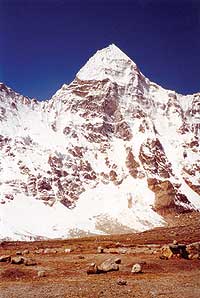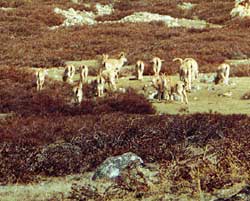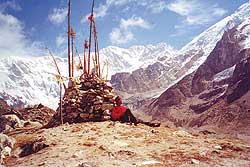 After you have done all the classic treks in Nepal, after you have seen Kala Patar and done Annapurna Sancutary there is another challenge that awaits you: Kangchenjunga.
After you have done all the classic treks in Nepal, after you have seen Kala Patar and done Annapurna Sancutary there is another challenge that awaits you: Kangchenjunga.
First off, Kangchenjunga is located in the easternmost part of Nepal, which gets triple the amount of annual rainfall compared to western Nepal-these mountains on the foothills of the world's third highest mountain get upwards of 3,500 mm of rain a year. The effect is most visible in the vegetation: thick, verdant forests with heavy undergrowth. Even at the height of the dry season, the jungle trails are moist and fresh. The rhododendron in eastern Nepal is some of the most spectacular, especially the Milke Danda range north of Taplejung which has been declared a sanctuary for Nepal's national flower. The whole trek through the moist forests is also an orchid enthusiast's delight. If orchids are actually parasites, then you could call the Tamur River basin a Parasite Paradise.
If there is another conservation area to be declared in Nepal, then it must be a Leech Sanctuary in the upper Tamur Valley where in the lush undergrowth of the forests on either side of the river is a diversity of leeches probably found nowhere else on earth. There at least 20 different types of blood-suckers: striped and black, spotted like leopards, small black ones, fat and brown ones that look like slugs, slender long ones that seem like they haven't had a good drink lately, and then the common leeches that flail their snouts at you from the bushes and rocks. There are environment-friendly ways to deal with these creatures, and the traditional method is to rub salt on the fellows and they will promptly drop off. However, to prevent from getting at your skin in the first place you can use the tobacco juice that porters prefer and rub it like a balm. It'll keep them at a safe distance.
Because of the higher rainfall, farmers are more prosperous, and there is more food. Eastern Nepal also borders India's Darjeeling district, where Nepalis have traditionally gone to work. They have brought back new ideas from the tourist and education centres of that hill station. This has broadened their outlook, and made the people of eastern Nepal more affluent and worldy-wise. Added exposure has come from Gurkha veterans, who spend their retirement in their ancestral homes in the villages of the Tamur Valley.  And for trekkers, the greatest thing about the Kangchenjunga trek is that you see very few other foreigners here. The area is now a National Park, and there are ACAP-type restrictions on travelling. There is no extra royalty to go in, but you have to pay the park fee. Individual ravel is discouraged, but this rule can
And for trekkers, the greatest thing about the Kangchenjunga trek is that you see very few other foreigners here. The area is now a National Park, and there are ACAP-type restrictions on travelling. There is no extra royalty to go in, but you have to pay the park fee. Individual ravel is discouraged, but this rule can
be sidestepped if you pretend your porter guides are your companions.
The trek is a challenge in other ways: although there is plenty of food, the villages are few and far between and you have to depend on your own provisions. The distances are also long from the road-head at Basantapur, Gopetar or the airport at Tumlingtar.
The views during the walk in are not as spectacular as in some of the other treks in Nepal, but once you get to the glaciers draining the north and south flanks of Kangchenjunga, the vistas are outstanding. Kangchenjunga is not a monolithic peak, like Dhaulagiri or Mt Everest, but a 10 km long ridge over 8,000 m high which makes its one of the largest mountain masses on earth. Kangchenjunga is tucked away in the northeastern corner of Nepal and is in the rainshadow. It has the same feel as Manang Valley, although the mountains here are even higher and nearer and crowd the sky. The upper stretch of the trek is along the crumbling lateral moraines of retreating glaciers, and can be treacherous in places because of rockfall. The trail leads up to the farther end of the valley, Jansang Pass to Tibet at 6,100 m.
This is a photogenic land, the villages even on the upper reaches are more prosperous, the terraces are meticulously carved out of the slopes, and although the area is remote and roadless, it is less underdeveloped than other, similar parts of Nepal.  A recommended 15-17 day trek would entail flying to Taplejung and taking the ridge route to Kangchenjunga south base camp, backtracking to Tseram and crossing over to the northern side. Taplejung is not so difficult anymore to fly to since private airlines began service.
A recommended 15-17 day trek would entail flying to Taplejung and taking the ridge route to Kangchenjunga south base camp, backtracking to Tseram and crossing over to the northern side. Taplejung is not so difficult anymore to fly to since private airlines began service.
Day 1: After arriving in Taplejung on the early morning flight start walking to Lali Kharka past picturesque multi-ethnic villages.
Day 2: Keswa. From the ridge there are good views of Jannu (also known as Kumbhakarna Himal), the mountain looms at the head of the valley and has a striking presence.
Day 3: Mamankhe is a Rai and Limbu village the houses surrounded by barley, millet and cornfields. The local tea-shops have great tongba where you can sip the warm drink with a bamboo straw and chat with English-speaking elderly ex-servicemen.
Day 4: Yamptudin is probably the only Gurung village this far east. Unlike their Rai or Limbu neighbours, they speak Nepali.
Day 5: Lamite Bhanjyang does not offer much of a view because of the thick forest of tall trees. Beyond here, there are only herders and shepherds to be seen taking livestock to high pastures.
Day 6: Tseram at 3,770m is the junction from where you branch off to the Yalung Glacier.
Day 7: Ramche at 4,800m is a yak shelter from where it is two-and-half-hours to the base camp for Kangchenjunga south face. Further up there is a broad glacier field at Oktang, a great place to camp if you don't have altitude symptoms.
Day 8: Race back to Tseram  Day 9: Rapka Kharka is a long day from Tseram, crossing two 4,800 m passes. From the exotically named Sinion La is a view to rival Poon Hill. Kangchenjunga and Jannu dominate the eastern horizon, to the west is the jagged ridge of Jaljale Himal which separates the Tamur and Arun watersheds, and far in the distance are Makalu and Everest. On a clear day, you see down to the Indian plains to the south.
Day 9: Rapka Kharka is a long day from Tseram, crossing two 4,800 m passes. From the exotically named Sinion La is a view to rival Poon Hill. Kangchenjunga and Jannu dominate the eastern horizon, to the west is the jagged ridge of Jaljale Himal which separates the Tamur and Arun watersheds, and far in the distance are Makalu and Everest. On a clear day, you see down to the Indian plains to the south.
Day 10: Ghunsa, site of a Tibetan Refugee Camp, is four-and-a-half hours down to the valley and you can reach in time for lunch.
Day 11: Rampuk Kharka. The day starts with a forest trail and slowly gets into moraine country with narrow trails and rock falls.
Day 12: Lhonak is like reaching Annapurna Sanctuary, but perhaps more spectacular. The north face of Kangchenjunga is visible with its three stacked glacier shelves from which seracs break off from time to time and tumble down in billowing clouds of ice. There are views of Kirat Chuli, Nepal Peak, and The Twins at the head of the valley. The valley itself goes on and on.
Day 13: Pangpema, even better views of the north face. Stay for two days if you have time, attain nirvana and soak in the silence and tranquillity.
Day 14: Can get right back down to Ghunsa in one day.
Day 15: Amjilasa.
Day 16: By Chirwa you are back in the low mid-hills with Bahun, Chhetri villages.
Day 17: Climb up to the ridge to get back to Taplejung for the flight back.


